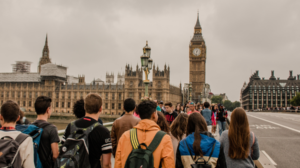As one of the largest cities in the world and a historical hub, it should be expected that, as in all things, London will be at the pinnacle of the art world. Having been host to some of the greatest artists in history, not to mention overall some of the greatest creative minds the world has ever seen.
Landmarks of London’s creative heritage are strewn across the city: Shakespeare’s globe theater adorns the banks of the River Thames and the awe-inspiring Royal Albert Hall towers over central London’s Kensington Gardens.
These buildings are joined in showcasing London’s impressive cultural and artistic heritage by the city’s impressive national art galleries, The National Gallery, Tate Britain, and Tate modern. All of these galleries are free to the public and hold works by renowned artists, but each nonetheless maintains distinct characteristics that set them apart from one another.
The National Gallery
As its name suggests, the national gallery was constituted to represent the whole of the United Kingdom’s artistic possessions. This was done in the early 1800s when the European nations began to collect privately-held collections into national galleries as a point of national prestige.
Now, the National Gallery sits prominently within a neoclassical facade of pillars and a central dome that dominates London’s famous Trafalgar Square. The gallery’s location in the center of London, surrounded by monuments and statues and countless historic buildings, does well to match the eminence that the gallery’s collection holds.
The museum’s main collection presents a walk through the history of art, starting with works by medieval and renaissance painters, including such known names as Da Vinci and El Greco, before ending in the modern era with impressionist painters such as Van Gogh and Manet. In addition to the many acclaimed works within its collection, the National Gallery is particularly known for the paintings of J.M.W Turner, perhaps the most well-known British painter.
The historic – almost encyclopedic – angle, housed in a uniquely historical-looking building at the heart of London’s heritage zone, make the National Gallery feel distinctly prominent, fitting its supposed role as a gallery for the whole of Britain.
Tate Britain
Still in central London but more removed from the urban chaos, the Tate Britain art gallery is more emblematic of the Thames embankment near which it is situated. Built in 1897, Tate Britain nonetheless aspires for a similar neoclassical look to the National Gallery and a similar encyclopedic approach to displaying its collection.
However, while the National Gallery strives to display the breadth of what European and world art can offer, Tate Britain has a more focused approach to its collection, attempting to compile a similarly comprehensive look primarily at British art, from the renaissance to modern times.
Because of this sharper look, Tate Britain overall provides a more varied offering of artworks with less of the intimidating grandeur of the National Gallery. The smaller scope means it’s possible to get a closer look at the development of art over the ages. For these reasons, Tate Britain has proven to be my favorite, with the ability to walk between a few rooms and see stylistic differences representing hundreds of years of art history.
Tate Modern
The final entry into the list sticks out in more ways than one. For starters, Tate Modern was opened only in the year 2000, more than a century after the opening of Tate Britain. Secondly, as the name suggests, Tate Modern has a focus on modern and contemporary art, featuring shifting exhibitions that aim to highlight contemporary artists and new developments in the art world. And lastly, and most noticeably, Tate Modern is housed in the hulking concrete façade of the former Bankside Power Station, a marked change from the white marble pillars, arches, and domes of the National Gallery and Tate Britain. Because of all these differences, I think Tate Modern’s best qualities lie in its uniqueness and distinctiveness.
In addition to these factors, Tate Modern is also unique in its East London location farther away from the more metropolitan corners of Central London. Its towering brick chimney presents an eclectic environment on the banks of the Thames alongside other nearby attractions. The Millennium Bridge across the river, with its unique sleek and modernist suspension design, accompanies Tate Modern in its distinctiveness, both of them contrasting with St. Paul’s cathedral across the river and Shakespeare’s globe theatre a short walk away.
Inside, Tate Modern continues to develop its unique character, filled with exhibitions that aim to continue art’s fundamental nature as a force constantly pushing boundaries. Currently, the gallery holds works by famous names such as Picasso and Pollock while also having exhibitions that aim to focus on contemporary art from underrepresented groups, such as a room with a focus on art from Indigenous Australian artists.
Conclusion
Overall, the times I’ve spent across these three very distinct art galleries, all free to the public, have been some of the most thought-provoking moments of my time in London. The diversity of cultural expressions which they offer, in many ways, embodies the city of London as a whole, which itself features a long and winding history building up to its current state as a wellspring of different bustling cultures, groups, and creative movements.










